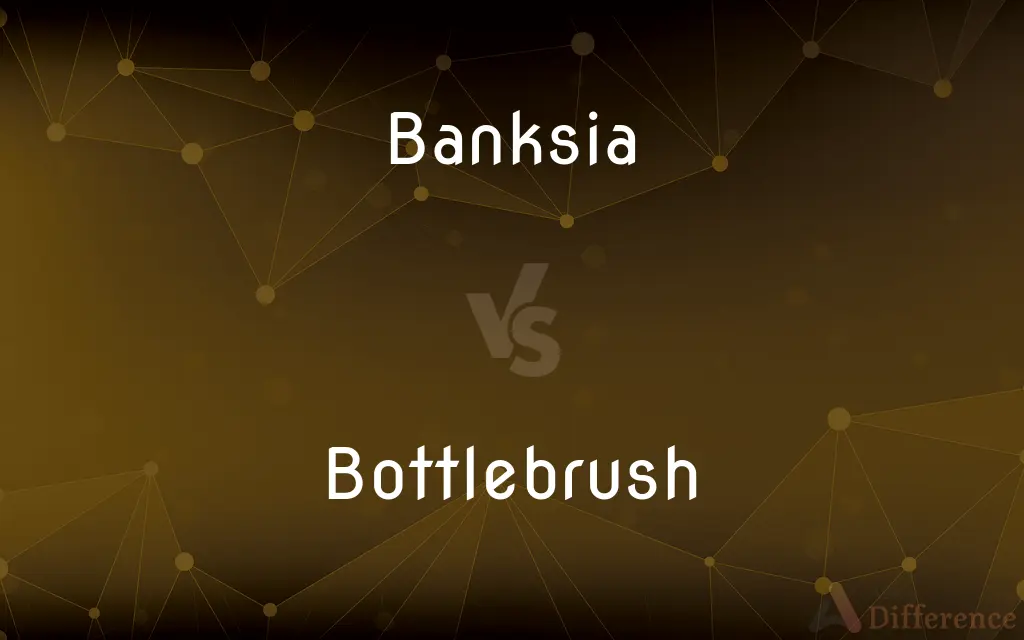Banksia vs. Bottlebrush — What's the Difference?
By Fiza Rafique & Maham Liaqat — Updated on March 28, 2024
Banksias are known for their unique flower spikes and woody cones, thriving in Australian bushland; whereas Bottlebrushes are celebrated for their vibrant, brush-like flowers, often attracting birds and bees.

Difference Between Banksia and Bottlebrush
Table of Contents
ADVERTISEMENT
Key Differences
Banksias are a distinctive group of plants primarily found in Australia, characterized by their large flower spikes and woody cones. These plants are adapted to nutrient-poor soils and often regenerate quickly after fires, a common occurrence in their native habitats. On the other hand, Bottlebrushes, belonging to the genus Callistemon, are renowned for their striking, brush-like flowers that appear in various colors, most commonly red. They are versatile, growing in a wide range of soils and conditions, and are popular in gardens for their appeal to birds and bees.
While Banksias can vary greatly in size, from small shrubs to large trees, they share a commonality in the structure of their flowers, which consist of hundreds of tiny florets packed together into dense spikes or cones. These structures are not only visually unique but also play a crucial role in the plant's reproduction, especially following bushfires. In contrast, Bottlebrush plants are generally shrubs or small trees, and their flowers are composed of numerous long stamens, giving them a soft, brush-like appearance. This floral arrangement is particularly effective in attracting pollinators, contributing to their ecological role in their environments.
Banksias have adapted to survive in fire-prone environments, with many species possessing the ability to release seeds from their woody cones only after exposure to fire. This ensures the propagation of the species in the wake of bushfires. Bottlebrush plants, while also resilient, do not rely on fire for seed dispersal. Instead, they benefit from attracting a variety of pollinators, including birds, bees, and insects, which aid in their reproduction.
The leaves of Banksias are often serrated or toothed, a trait that may deter herbivores and reduce water loss in their often arid environments. Whereas, Bottlebrush leaves are typically more variable, ranging from lanceolate to linear, and are usually not serrated. This difference in leaf morphology reflects their adaptation to various environmental conditions and functional roles within their ecosystems.
Cultivation and care requirements for Banksias and Bottlebrush plants also differ. Banksias generally prefer well-drained soils and are sensitive to phosphorus, requiring low-phosphorus fertilizers. Bottlebrushes are less finicky, adapting to a broader range of soil types and conditions, making them a more versatile choice for gardeners looking for low-maintenance plants.
ADVERTISEMENT
Comparison Chart
Native Habitat
Primarily Australian bushland
Australia, with some species in New Caledonia
Flower Characteristics
Spikes or cones, woody appearance
Vibrant, brush-like, colorful flowers
Growth Habit
Varies from shrubs to large trees
Mostly shrubs or small trees
Adaptation to Fire
Seeds often released post-fire
Does not rely on fire for seed dispersal
Leaf Morphology
Often serrated or toothed
Variable, generally not serrated
Pollination
Attracts specific birds and insects
Attracts a wide range of pollinators
Soil Preference
Well-drained, low phosphorus tolerance
Adaptable to a range of soils
Reproduction Strategy
Many rely on fire for seed release
Attracts pollinators without fire dependency
Cultivation
Requires specific conditions, sensitive to phosphorus
Easier, tolerates various conditions
Compare with Definitions
Banksia
A genus of plants native to Australia, known for their unique flower spikes and woody cones.
The Banksia serrata, with its serrated leaves and large cones, is a striking feature of the Australian bush.
Bottlebrush
Grows primarily as shrubs or small trees in diverse environments.
The weeping bottlebrush provides both shade and ornamental value in gardens.
Banksia
Adapted to poor soils and fire-prone environments.
After a bushfire, the Banksia cone releases seeds, ensuring the species' survival.
Bottlebrush
Can be used for ornamental purposes or natural fencing.
A hedge of bottlebrush not only adds privacy but also brings a splash of color to the landscape.
Banksia
Requires well-drained soils and low-phosphorus conditions for cultivation.
Gardeners growing Banksias need to be cautious of using high-phosphorus fertilizers.
Bottlebrush
Adaptable to a wide range of soil types, requiring minimal care.
Bottlebrush plants thrive in both wet and dry conditions, making them versatile garden choices.
Banksia
Attracts specific types of pollinators, including birds and bees.
The Banksia flowers are a vital source of nectar for the honeyeater birds.
Bottlebrush
A plant genus known for its vibrant, brush-like flowers, attracting various pollinators.
The crimson bottlebrush is a popular garden plant for its striking red flowers.
Banksia
Features varied growth forms from shrubs to trees.
The Banksia grandis can grow into a towering tree, unlike its smaller shrub counterparts.
Bottlebrush
Its flowers are especially attractive to birds, bees, and insects.
During flowering, bottlebrush bushes buzz with the activity of busy pollinators.
Banksia
Banksia is a genus of around 170 species in the plant family Proteaceae. These Australian wildflowers and popular garden plants are easily recognised by their characteristic flower spikes and fruiting "cones" and heads.
Bottlebrush
Any of various Australian shrubs or trees of the genus Callistemon, having dense cylindrical spikes of flowers with long stamens that resemble a brush used to clean bottles.
Banksia
Any of various evergreen shrubs or trees of the genus Banksia of Australia and New Guinea, having dense spikes of usually yellowish or reddish flowers and fruits in conelike clusters.
Bottlebrush
Any of various trees or shrubs of the myrtle family, especially of the genera Callistemon and Melaleuca, native to Australia and adjacent areas, having spikes of flowers with numerous conspicuous stamens.
Banksia
A plant belonging to the genus Banksia.
Bottlebrush
A cylindrical brush on a thin shaft that is used to clean bottles.
Banksia
Any shrub or tree of the genus Banksia having alternate leathery leaves apetalous yellow flowers often in showy heads and conelike fruit with winged seeds
Bottlebrush
An uncommon cave formation resulting from a rise in water level such that a stalactite becomes immersed in water that is supersaturated with calcium carbonate, causing the stalactite to become coated with pool spar.
Bottlebrush
A cylindrical brush on a thin shaft that is used to clean bottles.
Bottlebrush
A cylindrical brush on a thin shaft that is used to clean bottles
Common Curiosities
Where are Banksias and Bottlebrushes native to?
Banksias are primarily native to Australia, while Bottlebrushes are also Australian but some species extend to New Caledonia.
What makes Banksia flowers unique?
Banksia flowers are unique for their dense spikes or cones, consisting of hundreds of tiny florets.
Are Bottlebrush plants easy to care for?
Yes, Bottlebrush plants are adaptable to a range of soil types and conditions, making them relatively low-maintenance.
Can Banksias and Bottlebrushes be used in gardens?
Yes, both are popular in gardens; Banksias for their unique appearance and Bottlebrushes for their vibrant flowers and pollinator attraction.
How do Bottlebrush flowers attract pollinators?
Bottlebrush flowers, with their vibrant, brush-like stamens, are highly effective in attracting birds, bees, and insects.
How are the leaves of Banksias and Bottlebrushes different?
Banksia leaves are often serrated or toothed, whereas Bottlebrush leaves are more variable and usually not serrated.
How long do the flowers last?
Flower longevity varies by species, but Bottlebrush flowers generally have a longer bloom period compared to the more ephemeral bloom of Banksias.
Can Banksias grow in any soil type?
Banksias prefer well-drained soils and are sensitive to phosphorus, requiring specific soil conditions for optimal growth.
What are the main pollinators for these plants?
Banksias attract specific birds and insects, while Bottlebrushes attract a wider range of pollinators, including birds, bees, and insects.
Are there medicinal uses for these plants?
While not commonly known for medicinal uses, various parts of these plants have been used in traditional remedies and crafts.
Do both plants require fire for reproduction?
While many Banksias rely on fire for seed release, Bottlebrush plants do not depend on fire for their seed dispersal.
How do you propagate Banksias and Bottlebrushes?
Both can be propagated from seed or cuttings, with specific techniques varying by species.
What are the water requirements for these plants?
Banksias generally require well-drained conditions with moderate water, while Bottlebrushes can tolerate a wider range of moisture levels.
Can Banksias and Bottlebrushes grow in pots?
Yes, both can be grown in pots, but they require careful selection of pot size and soil type, especially Banksias due to their sensitivity to phosphorus.
Are Banksias and Bottlebrushes resistant to pests and diseases?
Both are relatively hardy, but they can be susceptible to specific pests and diseases, requiring appropriate management practices.
Share Your Discovery

Previous Comparison
Engage vs. Engagement
Next Comparison
Isomer vs. EpimerAuthor Spotlight
Written by
Fiza RafiqueFiza Rafique is a skilled content writer at AskDifference.com, where she meticulously refines and enhances written pieces. Drawing from her vast editorial expertise, Fiza ensures clarity, accuracy, and precision in every article. Passionate about language, she continually seeks to elevate the quality of content for readers worldwide.
Co-written by
Maham Liaqat













































